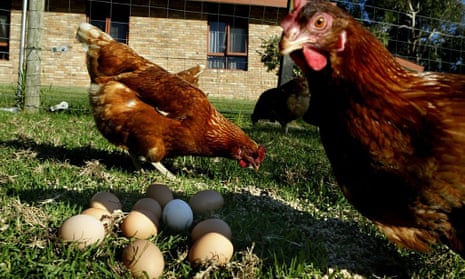Back yard chicken owners in Australia have been urged to implement biosecurity measures to prevent contact with wild birds in the wake of a global avian influenza outbreak.
Australia remains the only continent without HPAI H5 (high pathogenicity avian influenza of subtype H5), after scavenging skua birds on mainland Antartica tested positive for bird flu in February. Symptoms for affected birds include diarrhoea, sneezing, a reduction in egg production and sudden death.
The risk of infection in Australian wild birds is classified as high, after a risk assessment provided to the Department of Agriculture in December. The risk to poultry is listed as moderate to high.
Dr Melinda Cowan, a veterinary specialist in avian medicine, said her Sydney clinic is already making preparations for an outbreak.
“It’s critical that all bird owners, but especially our pet chicken owners, are aware of how to implement and potentially improve their own biosecurity measures,” she said. “And it’s sensible anyway.”
Cowan said authorities are worried about the disease being introduced by migrating seabirds and nomadic waterfowl. The highly virulent strain of the virus has been identified in more than 300 species of wild birds worldwide.
“We all need to really have our finger on the button,” she said. “We need to be very mindful of what’s going on overseas, there are definitely some things that we could implement straight away.”
Cowan said homes with back yard chickens or pet birds could reduce the risk of interaction with wild birds by creating netted, enclosed spaces and regularly changing and sanitising sources of food and water.
She said that while implementing biosecurity measures in small back yards may be challenging, “this will be the way that we can protect our beloved pet birds, if we implement these things now”.
“We are mentioning this concern so people can be alert but not alarmed. We are trying to educate people about this concern and what they can do to help their flock.”
Peter Laurence has four pet chooks in his back yard in Tempe, near wetland bird habitats in Sydney’s inner west. He said he was not aware of the risk from avian flu, and said there should be better communications from authorities to back yard chook owners.
“None of my friends who keep chickens are talking about bird flu, and we talk about our chooks a lot,” he said. “There’s very little awareness about the impact of diseases in the community with city flocks … we’ve been sheltered from so many agricultural diseases and viruses.”
Four chickens is considered a low risk of infection, because the disease requires larger flocks to spread. But with the family cat registered with his local council, Laurence said he would like to see a similar process for his chickens.
“I don’t see that it would be an inconvenience to have a chicken registered, particularly if it means that government would be able to get to us quickly if there was an outbreak … it would be really good if we could register our flock,” he said.
Poultry researcher Dr Peter Groves said bird owners needed to be vigilant to spot unwell birds before disease of any kind began to spread.
“The major risk to poultry in Australia would come from wild ducks or geese,” he said. “But to migrate, they need to be healthy and HPAI has killed huge numbers of them.”
Groves said for bird flu to arrive on Australian shores, an infected bird would have had to survive the flight from Antarctica to Australia and transmit the virus to local ducks or geese. Those wild birds would then need to survive long enough to circumvent biosecurity protections and come into contact with a chicken or turkey in a commercial operation.
“All of this is possible but probably very unlikely,” he said. “Poultry veterinarians regularly check poultry mortalities for the presence of avian influenza virus (AIV) and Newcastle Disease [a virus that causes paralysis and death] and monitor our status of freedom from these diseases.”
A spokesperson for the department of agriculture said Australia’s biosecurity system was one of “the most robust in the world” and the recent surge in cases was being closely monitored.
“While migratory birds do travel between Australia and parts of Asia where HPAI is present, the distance between Australia and our northern neighbours may reduce the likelihood of introduction of HPAI viruses,” they said.
“Australia has nationally agreed response arrangements in place to respond to emergency animal disease incursions and outbreaks, including for avian influenza.”
